- Understanding Influence in a Fragmented Market
- Why Influence Is Different in MENA
- Levels of Influence: Who’s Who?
- Cost vs. Impact: Micro vs. Mega Influencers
- Budget Efficiency for FMCG
- Frequency and Authenticity
- Regulations and Guidelines in MENA Markets
- Key Laws in UAE and KSA
- Common Pitfalls for FMCG Brands
- What to Look for in Contracts
- Campaign Examples: Local Successes
- Micro-Influencer Success in Egypt
- Lamana × Mogu Mogu (Iran): micro-influencer clusters + bilingual utility
- Lamana and Otaghak (Nowruz travel peak): one lead influencer + snackable reels
- Celebrity-Driven Campaign in the Gulf
- Blended Approach Example
- Influencer Marketing’s Impact on FMCG Brands
- Key Benefits for FMCG in the Region
- When to Use Which Type
- Cross-Channel Influence
- How to Choose the Right Influencer Type for Your FMCG Campaign
- Define Your Campaign Objective First
- Evaluate Audience Relevance Over Follower Count
- Vetting Criteria Before You Commit
- How Lamana Builds Influencer Partnerships
- Our Approach to Influencer Strategy
- How We Deliver Results
- Creator Relationship Building
- Influence Is Local, Trust Is Earned
Influencer marketing has become a reliable tool for FMCG companies across the Middle East as digital content continues to shape the way people connect with brands. But here’s the question: Does a bigger follower count always mean greater impact? Not necessarily.
In the MENA region, which is culturally diverse and fragmented, choosing between high-profile celebrities and micro-influencers can make a real difference in how a campaign performs. From consumer trust to engagement rates and overall cost-effectiveness, there is a lot to consider.
In this article, we will elaborate on the practical differences between working with celebrities and micro-influencers, share real campaign examples from the UAE, KSA, and Egypt, and show how brands like Lamana are building smarter, more effective influencer partnerships that actually deliver results.
Understanding Influence in a Fragmented Market
The MENA region presents a unique and diverse landscape for influencer marketing, shaped by cultural variety, fragmented platform use, and important language nuances. FMCG brands must adopt hyper-local strategies that respect the different audiences, from locals to experts, and leverage the right platforms and languages to build trust and engagement.
Understanding these key factors is essential before diving into specific market insights and platform habits.
Why Influence Is Different in MENA
- Cultural diversity & segmentation: The MENA region is highly diverse, so influencer marketing needs to be localized. In countries like the UAE, where according to the Economic Times, 89% of the population is expats, FMCG brands must tailor content for different audiences. What works for a local Emirati may not appeal to a Western expat or a Saudi consumer. The most effective influencers act like cultural translators, using local languages, dialects, and values to connect with different groups and build real trust that broad, global campaigns often miss.
- Fragmented platform habits: In MENA, social media usage is spread across multiple platforms, and there is no single app dominating all audiences. While Instagram is still widely used, Snapchat and TikTok have surged, especially among Gulf youth. For example, VeraContent states that Snapchat reaches over 76% of Saudis and nearly 90% of those aged 13-34, making it essential for youth engagement. TikTok’s growth is also massive: UAE and Saudi Arabia both exceed 100% reach, showing how central short-form video has become. The same article reported that Twitter (now X) has seen a drop in active users across MENA since 2013 but remains strong in markets like Saudi Arabia. This means FMCG brands need multi-platform strategies such as using Instagram for lifestyle content, Snapchat for daily stories, TikTok for viral trends, and YouTube for longer videos.
- Language nuances and trust: Language plays a major role, with local Arabic dialects and bilingual content boosting trust. Influencers using regional dialects or mixing Arabic and English connect better with diverse audiences, especially in markets like the UAE. Consumers prefer influencers who understand local culture and language, seeing them as trusted insiders. Arabic. Focused, culturally aware campaigns generally perform better than English-only ones.
Levels of Influence: Who’s Who?
In the Middle East, just like everywhere else, influencers aren’t all the same. They are grouped based on the size of their followings, which usually ties to how they influence their audience. Understanding these different tiers is key when picking the right influencer partners for an FMCG campaign.
- Mega / Celebrity Influencers (> 1 Million Followers): Mega influencers, like Huda Kattan (50M+ followers) and Khalid Al Ameri (10M+ followers), are big-name celebrities and top digital creators with huge reach across the region. They are great for driving public awareness but tend to have lower engagement rates and less personalized content. While MENA brands have traditionally focused on these stars for major campaigns, many are now shifting toward smaller, niche influencers for more authentic connections.
- Macro Influencers (100K–1M followers): Macro influencers are well-known creators with hundreds or thousands of followers, usually focused on a specific niche or region. A food blogger in Egypt with 500k followers or a tech reviewer in Saudi Arabia with 250k are two examples of them. They offer broad reach, city or country-wide, while still targeting certain audiences. For FMVG brands, they are ideal to connect with sizable but specific groups, like a fitness influencer across the Gulf promoting a sports drink. They balance wide exposure with a relatable, authentic connection to their followers.
- Micro-Influencers (10K–100K followers): Micro-influencers are smaller creators focused on niche or local audiences, like a UAE food Instagrammer with 50k followers or a Jordanian beauty blogger with 20k. They have highly engaged communities, and their followers trust and interact with them more deeply than with big celebrities. For example, a YOUGov survey found 58% of UAE consumers trust micro-influencers over celebrities. Micro-influencers with 5-10k followers often see the highest engagement rates in the UAE. For FMCG brands, partnering with several micro-influencers offers authentic endorsements, higher conversion rates, and lower costs compared to mega-celebrities. About 80% of consumers prefer micro-influencers over celebrity endorsements, driving marketers to shift budgets accordingly.
- Nano Influencers (<10K Followers): Nano influencers are everyday people with small, trusted local audiences, such as a foodie in Cairo or a mom in Riyadh. Their close-knit followers trust their recommendations, resulting in high engagement. They are ideal for local FMCG campaigns and peer-to-peer promotion. While one nano can’t reach masses alone, many working together create a strong word-of-mouth. With over 13 million nano influencers in MENA, they are a cost-effective and powerful marketing resource.
Image 2
Cost vs. Impact: Micro vs. Mega Influencers
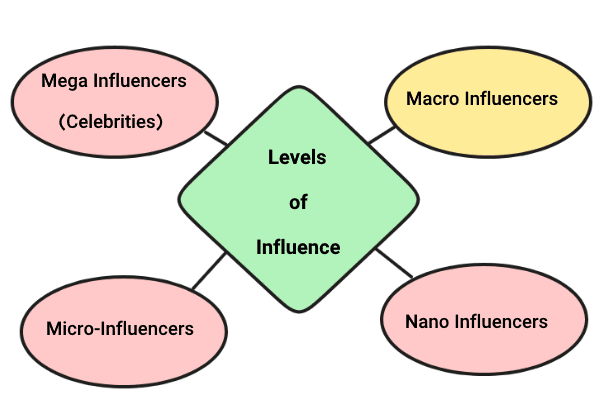
On the other hand, mega-influencers and celebrities bring huge reach and name recognition, but their impact in niche communities is weaker because their followers are broader, more passive, and less targeted.
From a cost perspective, micro-influencer campaigns are more efficient. Micros typically have lower CPMs and cost per engagement. For example, micro-influencers cost about $0.20 per engagement compared to roughly $0.33 for macro and mega influencers, a 40% lower cost per interaction.
In short, working with a group of smaller influencers often gets brands more impressions, interactions, and better engagement ROI for the same budget than relying on one big-name influencer.
Budget Efficiency for FMCG
For low-cost, low-margin products like FMCG, micro-influencers deliver better ROI because they cost much less and still drive strong sales. For example, LaCroix grew rapidly by working with many small influencers who promoted the product organically, often just for free samples. The statistics and figures on the Stack Influencer website indicate that micro-influencers generate more revenue per dollar spent than bigger influencers, with typical ROIs of 5:1 to 10:1 compared to 3:1 to 5:1 for macros or megas.
On the other hand, celebrity or mega-influencers create big spikes in awareness and are useful for launches or major campaigns but are too expensive for everyday marketing. FMCG brands often combine both approaches, using celebrities for broad initial reach and micros for ongoing engagement and conversions.
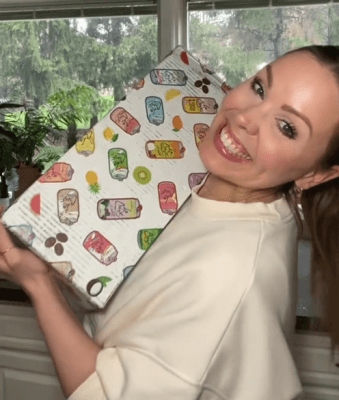
Frequency and Authenticity
Micro-influencers often promote products they genuinely use, which makes their content more authentic and consistent over time. This repeated engagement builds trust, one reason why 57% of marketers prefer them on platforms like Instagram.
For instance, the skincare brand Drunk Elephant works with micro-influencers who regularly share honest experiences using the products in their daily routines. Their content feels real and relatable, strengthening brand loyalty.
In contrast, celebrity endorsements tend to be one-off paid posts that feel less genuine. People are less likely to believe the celebrity actually uses the product. As a matter of fact, 92% of consumers trust influencers over celebrities, showing that authenticity matters more than fame.
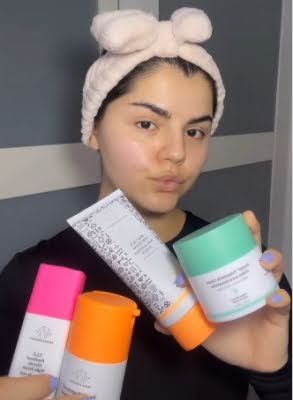
Regulations and Guidelines in MENA Markets
In MENA markets, especially in countries like the UAE and Saudi Arabia, regulations around influencer marketing are becoming more and more strict to promote transparency and protect consumers.
In the following section of this article, we will explore these regulations in countries such as the UAE and Saudi Arabia.
Key Laws in UAE and KSA
Influencer marketing in the UAE and Saudi Arabia is regulated by strict laws to ensure transparency, licensing, and consumer protection. FMCG brands and influencers must follow local rules to avoid fines and reputational risks.
- United Arab Emirates (UAE): In the UAE, influencers must hold an E-Media License and, as of 2025, a trade/commercial license to post sponsored content. Operating without these can lead to fines starting at AED 10,000, Boomerang explains. Brands partnering with unlicensed influencers also face regulatory and reputational risks.
- Saudi Arabia (KSA): Since 2022, Saudi Arabia requires all influencers who earn money from advertisements to obtain a permit from the General Commission for Audiovisual Media (GCAM). The license costs 15,000 and is valid for three years, allowing influencers to promote products on social media legally. Neoreach penalties for breaches include fines up to SAR 1,000,000 for hidden advertising, and promoting without a permit can lead to up to 5 years in prison or fines as high as SAR 5 million.
- Mandatory disclosure of ads: Influencers in the UAE and Saudi Arabia are legally required to disclose paid promotions. Posts must include clear tags such as #ad, #paid, #paid_partnership, or اعلان#. Vague phrases like “thanks to [Brand]” don’t meet legal standards. Failure to disclose can lead to penalties under consumer protection laws. Brands should ensure influencers follow these rules to stay compliant and maintain audience trust.
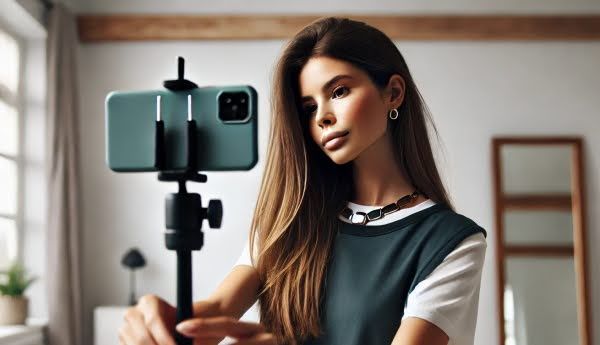
Common Pitfalls for FMCG Brands
When FMCG brands run influencer campaigns in MENA, they must navigate local regulations and cultural norms carefully. Read the following information to avoid pitfalls for FMCG brands.
- Unlicensed influencers: Partnering with unlicensed influencers is a major risk. In both the UAE and Saudi Arabia, it is illegal for influencers to advertise without the proper permits. As mentioned in Boomerang, in the UAE, brands must ensure the influencer holds an NMC Media License before signing any contract. Without it, the brand could face fines, account suspensions, or campaign shutdowns. Similarly, in Saudi Arabia, since the 2022 rules, influencers need a GCAM permit to operate legally. If they don’t have one, the brand could also be held accountable.
- Unclear contracts or deliverables: A common mistake is not having a clear influencer contract. Without details like the number of posts, key messages, required hashtags, or deadlines, influencers might create content that misses the goal or breaks local rules. Best practice is to spell everything out in writing: content formats (Instagram, Story, TikTok), how many of each, when to post, calls-to-action, and any platform-specific needs. The contract should also include legal requirements like licensing and compliance.
- Lack of localization: As highlighted in the Al Tamimi & Co. article, many global FMCG brands make the mistake of not adapting their content to local language and culture. What works in one country can fail, or even offend, in the Middle East. Running campaigns only in English for Arabic-speaking audiences or using visuals that clash with local values are some common issues. Many brands base content on their home country’s standard, which can result in messaging that offends or feels out of place. For example, a campaign might unintentionally violate conservative norms, religious sensitivities, or moral codes, issues taken very seriously in MENA. In the UAE, content that disrespects Islam or breaches public morality can lead to legal consequences.
What to Look for in Contracts
When creating or reviewing influencer contracts in MENA markets, brands should include clear terms that safeguard their interests and ensure all legal and regulatory requirements are met.
- Disclosure rules: Influencers must clearly label all sponsored content, using tags like #sd or the Arabic equivalent. UAE and KSA laws require transparent disclosure, and contracts should prohibit hiding the disclosure or using vague wording. Their terms should be clearly stated and agreed upon in advance.
- Content approval: Brands should have the right to review and approve influencer content before it is published. Contracts should control the review process, set timeframes, and allow brands to request changes or reject non-compliant content to avoid legal or cultural issues.
- Reuse rights for paid media: The contract must define how the brand can reuse influencer content, such as reposting it on social media, using it in ads, or featuring it on the brand’s website. Usage scope, duration, and modification rights should be clearly stated, including permission for paid amplification.
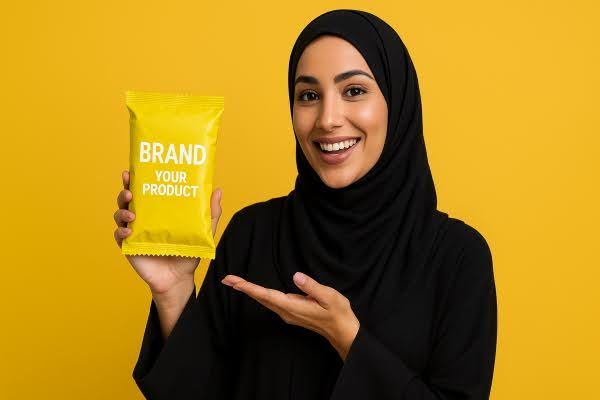
Campaign Examples: Local Successes
Local campaigns use influencers relevant to the community to create authentic connections. They focus on emotional stories, user content, and tailored messages, driving strong engagement and brand loyalty locally. Here are some related examples:
Micro-Influencer Success in Egypt
Stack Influence highlights that a personal care brand in Egypt launched a TikTok campaign around “morning routines,” teaming up with 25 micro-influencers in Cairo. Each one shared natural, relatable videos using the brand’s products, which really clicked with local audiences.
As a result, the brand saw a 12% rise in user-generated content, and engagement was nearly five times higher than the brand’s previous campaign that featured a celebrity.
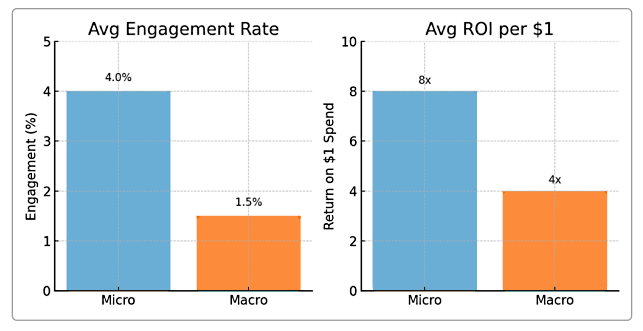
A great example of this is beauty brand NYX, which ran the #ButterGlossPop challenge on TikTok, garnering over 2 million UGC videos featuring the gloss and a 97% jump in engagement, showing how powerful peer-driven content can be.
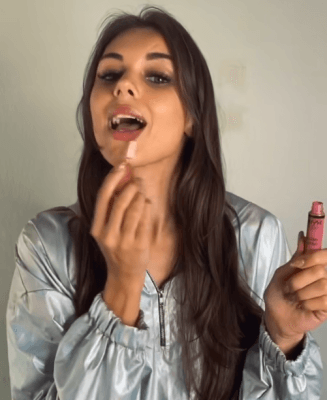
Lamana × Mogu Mogu (Iran): micro-influencer clusters + bilingual utility
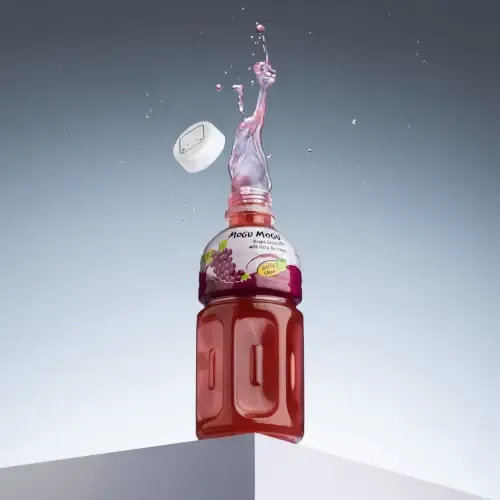
Lamana designed and ran a creator-led awareness program for Mogu Mogu that prioritized trust over sheer reach: 88 creators across “mother-and-child,” lifestyle, and Gen-Z clusters, all driving to a bilingual, informative landing page that taught shoppers how to spot the authentic product and discover flavor variants. The result: ~20M reach and 250K+ landing-page visitors, proving that localized micro-communities can out-convert celebrity blasts for FMCG.
Lamana and Otaghak (Nowruz travel peak): one lead influencer + snackable reels

During the Nowruz travel season, Lamana marketing agency built a humorous, culturally tuned travel narrative for Otaghak, fronted by popular influencer Mahyar Hasan and supported by three 15-second character reels. The creator-first approach made the story feel native to people’s feeds and delivered 7M views in 20 days with high shareability. evidence that a single, well-chosen local voice can outperform broad celebrity casts when the moment and insight are right.
Celebrity-Driven Campaign in the Gulf
In the Gulf region, a dairy brand took a classic approach by launching a campaign during Ramadan featuring none other than global football icon Cristiano Ronaldo. According to a report by CampaignME, the ad showed Ronaldo sipping camel milk and saying, “I love it. Ramadan Kareem,” in the locker room of his Saudi club, Al Nassr.
The timing, paired with Ronaldo’s star power, helped drive instant brand awareness. The ad ran during prime Ramadan programming on MBC, reaching over 9.3 million viewers, or 55% of the network’s audience.
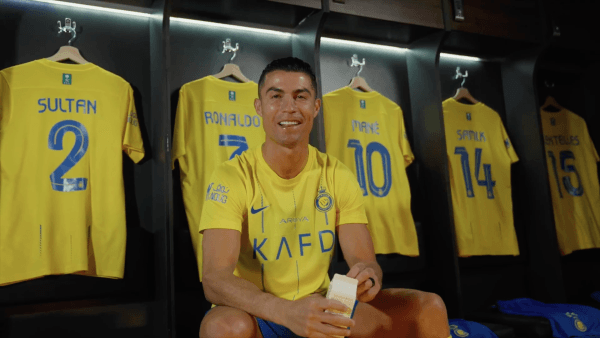
But there is a known catch with celebrity campaigns: they are good at drawing attention, but they often fall short on long-term engagement.
Research shows that only about 19% of consumers are influenced by celebrity ads. Most of them trust more relatable voices. In the Gulf dairy campaign, Ronaldo brought short-term attention but didn’t build lasting engagement with the audience.
Blended Approach Example
Unlike brands that rely only on celebrity partnerships, Nike’s influencer marketing strategy taps into a mix of macro- and micro-influencers to connect with their fans across the UAE. As reported in House of Marketers, it uses a layered influencer marketing funnel to build awareness, trust, and loyalty at every stage of the customer journey.
Brands that truly connect with people don’t rely on ads alone. They build trust, spark emotion, and invite audiences to be part of the story by:
- Using famous athletes to inspire
- Partnering with smaller influencers for authenticity
- Promoting user-generated content to build a community
- Focusing on emotional storytelling
- Giving influencers creative freedom
- Adapting content for each social platform
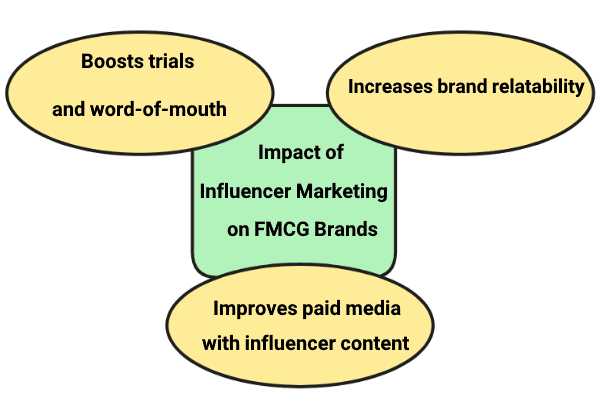
Influencer Marketing’s Impact on FMCG Brands
Influencer marketing boosts FMCG brands by building trust, expanding reach, and engaging audiences across platforms.
Key Benefits for FMCG in the Region
According to a Find Your Influence article, influencers have become a major driver for FMCG brands in regions like the Middle East because word-of-mouth and peer trust are highly valued. Influencers act as personal recommendations, which strongly resonate with local consumers.
The following highlights some of the advantages for FMCG brands in MENA.
- Drives product trials through recommendations
- Builds brand relatability and cultural connection
- Outperforms traditional ads in engagement and ROI
- Helps lower customer acquisition costs
- Enhances credibility across multiple marketing channels
When to Use Which Type
Influencer marketing isn’t one-size-fits-all. FMCG brands need to choose the right type of influencer based on their specific campaign goals. Generally, celebrity (macro-mega) influencers and micro-influencers work best in different contexts:
- Celebrity Influencers: They are best suited for product launches, brand repositioning, and campaigns that require brand visibility across multiple countries. Their large followings and fame help generate buzz quickly and elevate brand image on a large scale.
- Micro-influencers: They are ideal for long-term advocacy, localized messaging, and targeting specific consumer segments. They are highly trusted by their communities and work well in CRM-style retention efforts, such as ongoing content series or recipe collaborations that build brand loyalty over time.
Cross-Channel Influence
Micro-influencers often have loyal followings across TikTok, Instagram, and WhatsApp which make them great fro content marketing strategies. For example, a food creator might share quick videos on TikTok, detailed posts on Instagram, and run a WhatsApp group for fans. This cross-platform trust boosts their overall influence.
Influencer content works well in retargeting ads, email, and landing pages. One study published by Acadia showed influencer ads had 150% higher ROAS than brand ads. Their videos or reviews also increase conversions on product pages and improve email engagement.
How to Choose the Right Influencer Type for Your FMCG Campaign
In FMCG marketing, teaming up with influencers boosts brand awareness, builds consumer trust, and drives sales. But to get it right, it is important to pick the right kind of influencer for your specific campaign. The following walks you through the process.
Define Your Campaign Objective First
Start by clearly defining your campaign goal, whether it is brand awareness, audience engagement, product trials, or customer loyalty. Your objective determines the best influencer type to partner with.
- For brand awareness, choose celebrities or macro influencers with massive reach.
- For engagement, trials, and conversions, micro- and nano-influencers are more effective due to their closer, trusted relationships with followers.
Matching influencer types to the marketing funnel ensures better results and helps you choose influencers strategically.
Evaluate Audience Relevance Over Follower Count
When choosing influencers to work with, don’t get distracted by big follower numbers. What really matters is whether their audience is relevant to your brand and how engaged that audience is.
An influencer with just 20,000 highly engaged followers who match your target demographic can be far more valuable than someone with 200,000 followers who barely interact or don’t align with your market.
Look at their engagement rate. See how often their audience likes, comments, and shares compared to their follower count. This tells you how loyal and responsive their followers really are.
Also, check whether their audience fits your ideal customer profile. For FMCG brands, that means a food influencer whose followers are health-conscious home cooks in your region, not just a broad, random crowd.
According to Skeepers, studies show that people trust influencers who are authentic and speak directly to their interests. That’s why micro-influencers often outperform bigger ones; they usually have a more focused and loyal audience that actually pays attention to what they say.
Prioritize quality over quantity. Work with influencers who offer meaningful reach to the right people, not just those with bigger numbers.
Vetting Criteria Before You Commit
Before working with an influencer, take time to make sure they are a good fit for your brand. It is no longer about follower count. What matters is alignment, trust, and relevance.
- Content and tone: Check if their content style and messaging match your brand’s image. Avoid influencers whose tone or values are inconsistent with your brand identity. Also, make sure their content meets your brand’s safety standards.
- Previous partnership: Look at who they have worked with. Have they promoted competitors or too many unrelated products? Prior collaborations should reflect professionalism and industry relevance.
- Engagement Quality: Don’t just count likes. Read the comments as well. Do followers genuinely engage, ask questions, or share feedback? Authentic interaction is a sign of real influence.
- Credibility: Skim through their posts to see if there are any red flags, scandals, or negative behavior in the influencer’s history that could harm your brand’s reputation. Make sure they follow ad rules and maintain a clean, professional image.
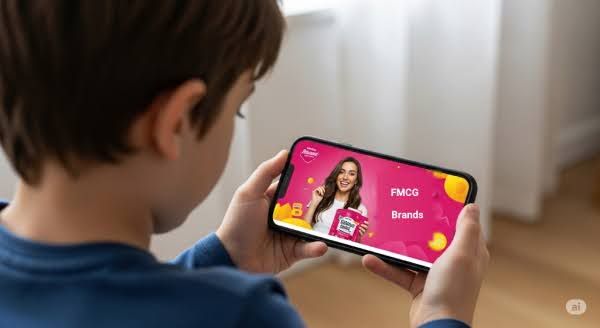
How Lamana Builds Influencer Partnerships
Lamana takes a strategic, relationship-first approach to influencer marketing. Rather than focusing on quick wins, we prioritize long-term partnerships that align with brand values and audience needs.
The next section explains what our overall strategy is, how we drive performance, and how we nurture strong creators.
Our Approach to Influencer Strategy
Lamana focuses on influencers who align with the brand’s values rather than those with large followings. We use data-driven tools, including AI, to find creators whose tone, niche, and audience truly match the brand. This often means choosing micro- and nano-influencers who deliver stronger engagement than big-name celebrities.
We also ensure each influencer aligns culturally and tonally with the brand. Local experts review content before launch to avoid tone-deaf messaging. By understanding the influencer’s humor, language, and style, Lamans tailors campaigns to each market because, as the CEO says, what works in one country might fail in another.
Finally, we start with small pilot tests to find what works best, refining content and cutting risks. Our strategy focuses on picking the right influencers, enduring cultural fit, and validating content before full launch.
How We Deliver Results
Lamana delivers results by running micro-influencer campaigns tailored to each stage of the product lifecycle, ensuring the right message reaches the right audience. They also boost impact by combining influencer content with paid media, driving both high engagement and real conversions.
- Lifecycle-based micro-influencer strategy: Micro- and nano-influencers are used strategically across product stages, from launch to maturity, to create authentic buzz and maintain ongoing engagement.
- Unified influencer and paid media campaigns: Influencer content is amplified through paid ads, blending authenticity with wide reach to maximize campaign effectiveness.
- Real-time performance dashboards: Transparent and live tracking of engagement, conversions, and brand lift allows for continuous optimization and data-driven decisions throughout the campaign.
Creator Relationship Building
Lamana prioritizes long-term ambassador programs over one-off influencer posts. By building ongoing relationships, influencers become genuine brand advocates, leading to more authentic, trusted content and stronger audience engagement.
Instead of just sending out briefs, Lamana trains creators and involves them in co-creation. Influencers are onboarded with values, style, and messaging, and collaborate in campaign planning and product feedback. This approach fosters deeper loyalty, higher-quality content, and a more credible connection between the brand and its audience.
Influence Is Local, Trust Is Earned
In the MENA region, influence is not just about content, it is about relevance. Micro-influencers often perform better than celebrities in engagement, trust, and ROI, thanks to their authentic connection with local audiences. Meanwhile, celebrities bring scale and visibility.
For brands in FMCG and beyond, the smartest approach is often a blended one; pairing trust with reach, and local insight with strategic impact.
If you are looking to build authentic, ROI-driven influencer campaigns in MENA, Lamana can help you find the right voice and make it heard in the right places.
